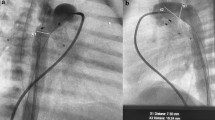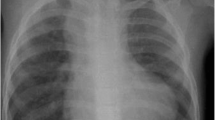Abstract
The aim of this study was to analyze patients diagnosed with chylothorax after congenital heart disease surgery among a cohort of neonatal patients, comparing the evolution, complications, and prognosis after surgery of patients who were and were not diagnosed with chylothorax, and to analyze possible risk factors that may predict the appearance of chylothorax in this population. Retrospective and observational study included all neonates (less than 30 days since birth) who underwent congenital heart disease surgery in a level III neonatal intensive care department. We included infants born between January 2014 and December 2019. We excluded those infants who were born before 34 weeks of gestational age or whose birth weight was less than 1800 g. We also excluded catheter lab procedures and patent ductus arteriosus closure surgeries. Included patients were divided into two groups depending on whether they were diagnosed with chylothorax or not after surgery, and both groups were compared in terms of perinatal-obstetrical information, surgical data, and NICU course after surgery. We included 149 neonates with congenital heart disease surgery. Thirty-one patients (20.8%) developed chylothorax, and in ten patients (32.3%), it was considered large volume chylothorax. Regarding the evolution of these patients, 22 infants responded to general dietetic measures, a catheter procedure was performed in 9, and 5 of them finally required pleurodesis. Cardiopulmonary bypass, median sternotomy, and delayed sternal closure were the surgical variables associated with higher risks of chylothorax. Patients with chylothorax had a longer duration of inotropic support and mechanical ventilation and took longer to reach full enteral feeds. As complications, they had higher rates of cholestasis, catheter-related sepsis, and venous thrombosis. Although there were no differences in neonatal mortality, patients with chylothorax had a higher rate of mortality after the neonatal period. In a multiple linear regression model, thrombosis and cardiopulmonary bypass multiplied by 10.0 and 5.1, respectively, the risk of chylothorax and have an umbilical vein catheter decreases risk.
Conclusion: We have found a high incidence of chylothorax after neonatal cardiac surgery, which prolongs the average stay and causes significant morbidity and mortality. We suggested that chylothorax could be an underestimated complication of congenital heart disease surgery during the neonatal period.
What is Known: • Acquired chylothorax in the neonatal period usually appears as a complication of congenital heart disease surgery, being the incidence quite variable among the different patient series (2.5–16.8%). The appearance of chylothorax as a complication of a cardiac surgery increases both mortality and morbidity in these patients, which makes it a quality improvement target in the postsurgical management of this population. | |
What is New: •Most of the published studies include pediatric patients of all ages, from newborns to teenagers, and there is a lack of studies focusing on neonatal populations. The main strength of our study is that it reports, to the best of our knowledge, one of the largest series of neonatal patients receiving surgery for congenital heart disease in the first 30 days after birth. We have found a high incidence of chylothorax after cardiac surgery during the neonatal period compared to other studies. We suggested that chylothorax could be an underestimated complication of congenital heart disease surgery during this period of life. |


Similar content being viewed by others
Data availability
The datasets generated during and/or analyzed during the current study are not publicity available, but are available from the corresponding author on a reasonable request.
Abbreviations
- CLFD:
-
Central lymphatic flow disorder
- CoA:
-
Coarctation of the aorta
- CP:
-
Chyloperitoneum
- CT:
-
Chylothorax
- CRBSI:
-
Catheter-related bloodstream infection
- ECC:
-
Extra corporeal circulation
- ECMO:
-
Extracorporeal membrane oxygenation
- HLHS:
-
Hypoplastic left heart syndrome
- IQR:
-
Median and interquartile ranges
- LVC:
-
Large volume chylothorax
- MCT:
-
Medium chain triglyceride formula
- PICC:
-
Peripherally inserted central catheter
- PLPS:
-
Pulmonary lymphatic perfusion syndrome
- RACHS:
-
Risk Adjusted Congenital Heart Surgery Score
- TAPVR:
-
Total anomalous pulmonary venous return
- TGA:
-
Transposition of the great arteries
References
Rocha G, Arnet V, Soares P et al (2021) Chylothorax in the neonate—a stepwise approach algorithm. Pediatr Pulmonol 56:3093–3105
Benítez I, Copons C, Castillo F (2008) Avances en terapéutica: Tratamiento del quilotórax. Anales de Pediatria Continuada 6:159–165. https://doi.org/10.1016/S1696-2818(08)74871-6
Beghetti M, la Scala G, Belli D et al (2000) Etiology and management of pediatric chylothorax. J Pediatr 136:653–658. https://doi.org/10.1067/mpd.2000.104287
Borasino S, Diaz F, el Masri K et al (2014) Central venous lines are a risk factor for chylothorax in infants after cardiac surgery. World J Pediatr Congenit Heart Surg 5:522–526. https://doi.org/10.1177/2150135114550723
Christofe NM, Pessotti CFX, Paiva L, Jatene IB (2017) Incidence and treatment of chylothorax in children undergoing corrective surgery for congenital heart diseases. Braz J Cardiovasc Surg 32:390–393. https://doi.org/10.21470/1678-9741-2017-0011
Costa KM, Saxena AK (2018) Surgical chylothorax in neonates: management and outcomes. World J Pediatr 14:110–115. https://doi.org/10.1007/s12519-018-0134-x
Efrati O, Barak A (2002) Pleural effusions in the pediatric population. Pediatr Rev 23:417–426
Church JT, Antunez AG, Dean A et al (2017) Evidence-based management of chylothorax in infants. J Pediatr Surg 52:907–912. https://doi.org/10.1016/j.jpedsurg.2017.03.010
Tutor JD (2014) Chylothorax in infants and children. Pediatrics 133:722–733. https://doi.org/10.1542/peds.2013-2072
Copons Fernández C, Benítez Segura I, Castillo Salinas F, Salcedo Abizanda S (2008) Neonatal chylothorax: aetiology, clinical course and efficacy of treatment. An Pediatr (Barc) 68:224–231. https://doi.org/10.1157/13116701
Jenkins KJ, Gauvreau K, Newburger JW et al (2002) Consensus-based method for risk adjustment for surgery for congenital heart disease. J Thorac Cardiovasc Surg 123:110–118. https://doi.org/10.1067/mtc.2002.119064
Mery CM, Moffett BS, Khan MS et al (2014) Incidence and treatment of chylothorax after cardiac surgery in children: analysis of a large multi-institution database. J Thorac Cardiovasc Surg 147:678–86.e1; discussion 685–6. https://doi.org/10.1016/j.jtcvs.2013.09.068
Day TG, Zannino D, Golshevsky D et al (2018) Chylothorax following paediatric cardiac surgery: a case-control study. Cardiol Young 28:222–228. https://doi.org/10.1017/S1047951117001731
Matsuo S, Takahashi G, Konishi A, Sai S (2013) Management of refractory chylothorax after pediatric cardiovascular surgery. Pediatr Cardiol 34:1094–1099. https://doi.org/10.1007/s00246-012-0607-y
Biewer ES, Zürn C, Arnold R et al (2010) Chylothorax after surgery on congenital heart disease in newborns and infants -risk factors and efficacy of MCT-diet. J Cardiothorac Surg 5:127. https://doi.org/10.1186/1749-8090-5-127
Kazanci SY, McElhinney DB, Thiagarajan R et al (2013) Obstruction of the superior vena cava after neonatal extracorporeal membrane oxygenation: association with chylothorax and outcome of transcatheter treatment. Pediatr Crit Care Med 14:37–43. https://doi.org/10.1097/PCC.0b013e31825b5270
Giglia TM, Massicotte MP, Tweddell JS et al (2013) Prevention and treatment of thrombosis in pediatric and congenital heart disease: a scientific statement from the American Heart Association. Circulation 128:2622–2703. https://doi.org/10.1161/01.cir.0000436140.77832.7a
Manlhiot C, Menjak IB, Brandão LR et al (2011) Risk, clinical features, and outcomes of thrombosis associated with pediatric cardiac surgery. Circulation 124:1511–1519. https://doi.org/10.1161/CIRCULATIONAHA.110.006304
Murphy LD, Benneyworth BD, Moser EAS et al (2018) Analysis of patient characteristics and risk factors for thrombosis after surgery for congenital heart disease. Pediatr Crit Care Med 19:1146–1152. https://doi.org/10.1097/PCC.0000000000001743
Anton N, Cox PN, Massicotte MP et al (2009) Heparin-bonded central venous catheters do not reduce thrombosis in infants with congenital heart disease: a blinded randomized, controlled trial. Pediatrics 123:e453–e458. https://doi.org/10.1542/peds.2008-1508
McCulloch MA, Conaway MR, Haizlip JA et al (2008) Postoperative chylothorax development is associated with increased incidence and risk profile for central venous thromboses. Pediatr Cardiol 29:556–561. https://doi.org/10.1007/s00246-007-9140-9
Faraoni D, Emani S, Halpin E et al (2017) Relationship between transfusion of blood products and the incidence of thrombotic complications in neonates and infants undergoing cardiac surgery. J Cardiothorac Vasc Anesth 31:1943–1948. https://doi.org/10.1053/j.jvca.2017.04.039
Bauman ME, Moher C, Bruce AK et al (2013) Chylothorax in children with congenital heart disease: incidence of thrombosis. Thromb Res 132:e83–e85. https://doi.org/10.1016/j.thromres.2013.06.014
Bernet-Buettiker V, Waldvogel K, Cannizzaro V, Albisetti M (2006) Antithrombin activity in children with chylothorax. Eur J Cardiothorac Surg 29:406–409. https://doi.org/10.1016/j.ejcts.2005.12.015
Kaipa S, Mastropietro CW, Bhai H et al (2020) Upper body peripherally inserted central catheter in pediatric single ventricle patients. World J Cardiol 12:484–491. https://doi.org/10.4330/wjc.v12.i10.484
Tawhai P, van den Boom J, Cama J (2022) Chylothorax associated with a PICC line in a very low birth weight infant. J Pediatr Surg Case Rep 76. https://doi.org/10.1016/j.epsc.2021.102120
Hsu H-F, Chou Y-H, Wang C-R, Wu S-C (2003) Catheter-related superior vena cava syndrome complicated by chylothorax in a premature infant. Chang Gung Med J 26:782–786
Oulego-Erroz I, Fernández-García A, Álvarez-Juan B et al (2020) Ultrasound-guided supraclavicular cannulation of the brachiocephalic vein may reduce central line-associated bloodstream infection in preterm infants. Eur J Pediatr 179:1655–1663. https://doi.org/10.1007/s00431-020-03663-y
Habas F, Baleine J, Milési C et al (2018) Supraclavicular catheterization of the brachiocephalic vein: a way to prevent or reduce catheter maintenance-related complications in children. Eur J Pediatr 177:451–459. https://doi.org/10.1007/s00431-017-3082-x
Sánchez Luna M, Caballero Martín S, Gomez S, de Orgaz MDC et al (2020) Skimmed breast milk in newborns with chylothorax: options with a personalised nutrition unit. An Pediatr (Engl Ed) 93:194–195. https://doi.org/10.1016/j.anpedi.2019.10.011
Fernández Alvarez JR, Kalache KD, Graŭel EL (1999) Management of spontaneous congenital chylothorax: oral medium-chain triglycerides versus total parenteral nutrition. Am J Perinatol 16:415–420. https://doi.org/10.1055/s-1999-6816
Zheng J, Chen Y-Y, Zhang C-Y et al (2020) Incidence and nutritional management of chylothorax after surgery for congenital heart diseases in children. Heart Surg Forum 23:E902–E906. https://doi.org/10.1532/hsf.3219
Bellini C, Cabano R, de Angelis LC et al (2018) Octreotide for congenital and acquired chylothorax in newborns: a systematic review. J Paediatr Child Health 54:840–847. https://doi.org/10.1111/jpc.13889
Loomba RS, Wong J, Davis M et al (2021) Medical interventions for chylothorax and their impacts on need for surgical intervention and admission characteristics: a multicenter, retrospective insight. Pediatr Cardiol 42:543–553. https://doi.org/10.1007/s00246-020-02512-x
Savla JJ, Itkin M, Rossano JW, Dori Y (2017) Post-operative chylothorax in patients with congenital heart disease. J Am Coll Cardiol 69:2410–2422. https://doi.org/10.1016/j.jacc.2017.03.021
Stringel G, Mercer S, Bass J (1984) Surgical management of persistent postoperative chylothorax in children. Can J Surg 27:543–546
Allen EM, van Heeckeren DW, Spector ML, Blumer JL (1991) Management of nutritional and infectious complications of postoperative chylothorax in children. J Pediatr Surg 26:1169–1174. https://doi.org/10.1016/0022-3468(91)90325-n
le Nué R, Molinaro F, Gomes-Ferreira C et al (2010) Surgical management of congenital chylothorax in children. Eur J Pediatr Surg 20:307–311. https://doi.org/10.1055/s-0030-1254164
Author information
Authors and Affiliations
Contributions
Alba Pérez-Pérez and Sara Vigil-Vázquez designed the study, performed the acquisition and analysis of the data, and draft the text. Gonzalo Solís-García and Ana Gutiérrez-Vélez collected data. The rest of the authors made contributions to the conception of the work and revised the work critically. All the authors revised and approved the final version of the text.
Corresponding author
Ethics declarations
Ethics approval
The study was approved by the Hospital Research Ethics Committee.
Competing interests
The authors declare no competing interests.
Additional information
Communicated by Daniele De Luca.
Publisher's Note
Springer Nature remains neutral with regard to jurisdictional claims in published maps and institutional affiliations.
Rights and permissions
Springer Nature or its licensor (e.g. a society or other partner) holds exclusive rights to this article under a publishing agreement with the author(s) or other rightsholder(s); author self-archiving of the accepted manuscript version of this article is solely governed by the terms of such publishing agreement and applicable law.
About this article
Cite this article
Pérez-Pérez, A., Vigil-Vázquez, S., Gutiérrez-Vélez, A. et al. Chylothorax in newborns after cardiac surgery: a rare complication?. Eur J Pediatr 182, 1569–1578 (2023). https://doi.org/10.1007/s00431-023-04808-5
Received:
Revised:
Accepted:
Published:
Issue Date:
DOI: https://doi.org/10.1007/s00431-023-04808-5




